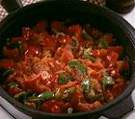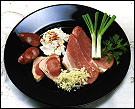| |
|
| |
Zagorski
Strukli |
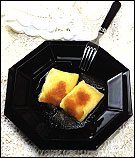 |
Zagorski
Strukli (or "Štrukli a la Zagorje") is a well-known dish from the
Zagorje and Prigorje regions around the city of Zagreb. The rich filling
has for a long time made štrukli a much-appreciated speciality despite
the fact that the ingredients could be found in even the most impoverished
rural homestead. Indeed, it is the readily available character of
necessary ingredients that resulted in several variants of this dish,
adapted to the customs of individual areas. |
| |
Istrian
Yota (Stew) |
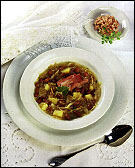 |
This
dish is, as its name implies, a meal characteristic of Istria and
is prepared from sauerkraut, beans, smoke-dried meats and various
kinds of seasoning. |
| |
Sauerkraut
Lika style |
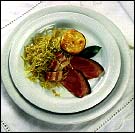 |
This
traditional dish from Lika will make a welcome addition to the menu
during the winter months. This meal always consists of sauerkraut
and smoked meat, sausage or bacon, and is eaten with a dish of potatoes
boiled in their jackets, or baked potato halves in their jackets.
|
| |
Turkey
with mlinci |
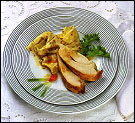 |
Mlinci
is a kind of side dish prepared from fat-free dough. It should be
cooked trough but not to the point of being mushy. This is a speciality
typical of Hrvatsko zagorje and its name originates from its shape,
which resembles, in its uncooked state, a mill stone. Mlinci go particularly
well with poultry. Hen turkey with mlinci is a dish that has become
almost a synonym for the cuisine of Zagorje and the areas surrounding
Zagreb. It is served at every festive gathering during autumn and
winter, beginning with All Saints. |
| |
Lamb
baked in a cripnja (sace or peka) |
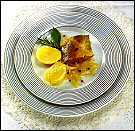 |
This
renowned and extremely tasty dish originates from times now long past,
when rural communities prepared their meals on an open fire and under
an inverted bowl. It is called variously a čripnja, a peka or a saće,
in different regions. For the benefit of contemporary tourists through,
this dish is usually prepared in a round or oval oven proof enameled
or stainless steel liddle vessel which is placed on a hot, fire-clay
slab. |
| |
Scampi
or shellfish buzara |
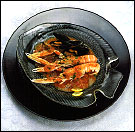 |
As
much as it almost primevally simple to prepare, so is buzara an etymological
mystery. Despite exhaustive research, no similar word can be found
in any affiliated language, nor in the languages of our geographical
neighbours. The closest expression, found in Venetian dialect, means
a "folly, stupidity, nonsense," or "slops a hotchpotch, a mixture
of all and everything." But it is hardly likely that anybody would
describe scampi, mussels or date shells - prepared only with oil,
garlic, parsley and wine (but absolutely never with onions) - as slops.
It is far more likely that this is an autochthonous Croatian dish
from the Adriatic coastal regions. |
| |
Novalja
marinade |
 |
This
is a well-known fish dish with various modes of preparation and containing
various ingredients, two of which are standard: there will always
be a marinade made from oil and wine vinegar (kvasina) and, if possible,
several types of fish. This particular recipe comes from Novalja on
the island of Pag, where it is known as "ribe na saur" (savoury fish).
Elsewhere along Croatia's Adriatic coast we find names such as "riba
na savur," "riba na sajur," meaning simply "fish marinade."
|
| |
|
| |
|
| |
|
| |
|
|
